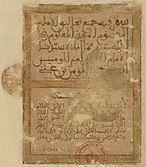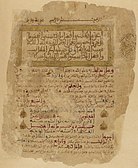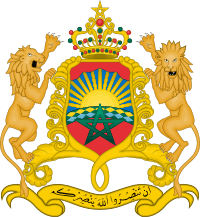Almohad Caliphate
The Almohad Caliphate (/ɑːlməˈhɑːd/; from Arabic المُوَحِّدون (al-Muwaḥḥidūn, "the monotheists" or "the unifiers") or Banu Abd al-Mumin[9] (from Arabic: بنو عبد المؤمن) was a North African Berber Muslim movement and empire founded in the 12th century.[10][11][12]
Almohad Caliphate الموحدون (Al-Muwaḥḥidūn) (in Arabic) | |||||||||||||||||||||||||||||||||||
|---|---|---|---|---|---|---|---|---|---|---|---|---|---|---|---|---|---|---|---|---|---|---|---|---|---|---|---|---|---|---|---|---|---|---|---|
| 1121–1269 | |||||||||||||||||||||||||||||||||||
 Flag | |||||||||||||||||||||||||||||||||||
| Status | Ruling dynasty of Morocco; Caliphate (since 1147) | ||||||||||||||||||||||||||||||||||
| Capital | Tinmel (1121–1147) Marrakesh (1147–1269) In Al-Andalus: Seville (1147–1162) Córdoba (1162–1163) Seville (1163–1248)[5] | ||||||||||||||||||||||||||||||||||
| Common languages | Arabic, Berber, Mozarabic | ||||||||||||||||||||||||||||||||||
| Religion | Sunni Islam (Creed: Ash'ari; Madhab: Zahiri) | ||||||||||||||||||||||||||||||||||
| Government | Caliphate | ||||||||||||||||||||||||||||||||||
| Caliph | |||||||||||||||||||||||||||||||||||
• 1121–1130 | Ibn Tumart (first, under title of "Mahdi") | ||||||||||||||||||||||||||||||||||
• 1130–1163 | Abd al-Mu'min (first, under title of "Caliph" from 1147) | ||||||||||||||||||||||||||||||||||
• 1266–1269 | Abu al-Ula al-Wathiq Idris (last) | ||||||||||||||||||||||||||||||||||
| History | |||||||||||||||||||||||||||||||||||
• Established | 1121 | ||||||||||||||||||||||||||||||||||
• Almoravids overthrown | 1147 | ||||||||||||||||||||||||||||||||||
| 1212 | |||||||||||||||||||||||||||||||||||
• Marinid suzerainty | 1248 | ||||||||||||||||||||||||||||||||||
• Disestablished | 1269 | ||||||||||||||||||||||||||||||||||
| Area | |||||||||||||||||||||||||||||||||||
| 1150 est.[6] | 2,300,000 km2 (890,000 sq mi) | ||||||||||||||||||||||||||||||||||
| 1200 est.[7] | 2,000,000 km2 (770,000 sq mi) | ||||||||||||||||||||||||||||||||||
| Currency | Dinar[8] | ||||||||||||||||||||||||||||||||||
| |||||||||||||||||||||||||||||||||||
Part of a series on the |
|---|
| History of Morocco |
 |
|
|
Related topics
|
|
|
The Almohad movement was founded by Ibn Tumart among the Berber Masmuda tribes in the south of modern Morocco. Around 1120, the Almohads first established a Berber state in Tinmel in the Atlas Mountains.[10] They succeeded in overthrowing the ruling Almoravid dynasty governing Morocco by 1147, when Abd al-Mu'min al-Gumi (r. 1130–1163) conquered Marrakesh and declared himself caliph. They then extended their power over all of the Maghreb by 1159. Al-Andalus soon followed, and all of Muslim Iberia was under Almohad rule by 1172.[13]
The Almohad dominance of Iberia continued until 1212, when Muhammad III, "al-Nasir" (1199–1214) was defeated at the Battle of Las Navas de Tolosa in the Sierra Morena by an alliance of the Christian princes of Castile, Aragon and Navarre. Nearly all of the Moorish dominions in Iberia were lost soon afterwards, with the great Moorish cities of Cordova and Seville falling to the Christians in 1236 and 1248 respectively.
The Almohads continued to rule in Africa until the piecemeal loss of territory through the revolt of tribes and districts enabled the rise of their most effective enemies, the Marinids, in 1215. The last representative of the line, Idris al-Wathiq, was reduced to the possession of Marrakesh, where he was murdered by a slave in 1269; the Marinids seized Marrakesh, ending the Almohad domination of the Western Maghreb.
History
Origins
The Almohad movement originated with Ibn Tumart, a member of the Masmuda, a Berber tribal confederation of the Atlas Mountains of southern Morocco. At the time, Morocco, and much of the rest of North Africa (Maghreb) and Spain (al-Andalus), was under the rule of the Almoravids, a Sanhaja Berber dynasty. Early in his life, Ibn Tumart went to Spain to pursue his studies, and thereafter to Baghdad to deepen them. In Baghdad, Ibn Tumart attached himself to the theological school of al-Ash'ari, and came under the influence of the teacher al-Ghazali. He soon developed his own system, combining the doctrines of various masters. Ibn Tumart's main principle was a strict unitarianism (tawhid), which denied the independent existence of the attributes of God as being incompatible with His unity, and therefore a polytheistic idea. Ibn Tumart represented a revolt against what he perceived as anthropomorphism in Muslim orthodoxy. His followers would become known as the al-Muwaḥḥidūn ("Almohads"), meaning those who affirm the unity of God.
After his return to the Maghreb c. 1117, Ibn Tumart spent some time in various Ifriqiyan cities, preaching and agitating, heading riotous attacks on wine-shops and on other manifestations of laxity. He laid the blame for the latitude on the ruling dynasty of the Almoravids, whom he accused of obscurantism and impiety. He also opposed their sponsorship of the Maliki school of jurisprudence, which drew upon consensus (ijma) and other sources beyond the Qur'an and Sunnah in their reasoning, an anathema to the stricter Zahirism favored by Ibn Tumart. His antics and fiery preaching led fed-up authorities to move him along from town to town. After being expelled from Bejaia, Ibn Tumart set up camp in Mellala, in the outskirts of the city, where he received his first disciples – notably, al-Bashir (who would become his chief strategist) and Abd al-Mu'min (a Zenata Berber, who would later become his successor).
In 1120, Ibn Tumart and his small band of followers proceeded to Morocco, stopping first in Fez, where he briefly engaged the Maliki scholars of the city in debate. He even went so far as to assault the sister of the Almoravid emir ʿAli ibn Yusuf, in the streets of Fez, because she was going about unveiled, after the manner of Berber women. After being expelled from Fez, he went to Marrakesh, where he successfully tracked down the Almoravid emir Ali ibn Yusuf at a local mosque, and challenged the emir, and the leading scholars of the area, to a doctrinal debate. After the debate, the scholars concluded that Ibn Tumart's views were blasphemous and the man dangerous, and urged him to be put to death or imprisoned. But the emir decided merely to expel him from the city.
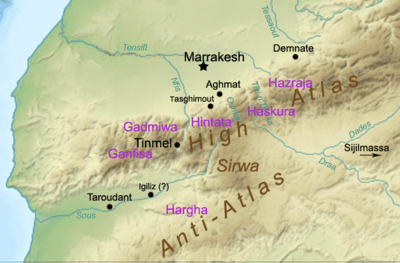
Ibn Tumart took refuge among his own people, the Hargha, in his home village of Igiliz (exact location uncertain), in the Sous valley. He retreated to a nearby cave, and lived out an ascetic lifestyle, coming out only to preach his program of puritan reform, attracting greater and greater crowds. At length, towards the end of Ramadan in late 1121, after a particularly moving sermon, reviewing his failure to persuade the Almoravids to reform by argument, Ibn Tumart 'revealed' himself as the true Mahdi, a divinely guided judge and lawgiver, and was recognized as such by his audience. This was effectively a declaration of war on the Almoravid state.
On the advice of one of his followers, Omar Hintati, a prominent chieftain of the Hintata, Ibn Tumart abandoned his cave in 1122 and went up into the High Atlas, to organize the Almohad movement among the highland Masmuda tribes. Besides his own tribe, the Hargha, Ibn Tumart secured the adherence of the Ganfisa, the Gadmiwa, the Hintata, the Haskura, and the Hazraja to the Almohad cause. Around 1124, Ibn Tumart erected the ribat of Tinmel, in the valley of the Nfis in the High Atlas, an impregnable fortified complex, which would serve both as the spiritual center and military headquarters of the Almohad movement.
For the first eight years, the Almohad rebellion was limited to a guerilla war along the peaks and ravines of the High Atlas. Their principal damage was in rendering insecure (or altogether impassable) the roads and mountain passes south of Marrakesh – threatening the route to all-important Sijilmassa, the gateway of the trans-Saharan trade. Unable to send enough manpower through the narrow passes to dislodge the Almohad rebels from their easily defended mountain strong points, the Almoravid authorities reconciled themselves to setting up strongholds to confine them there (most famously the fortress of Tasghîmût that protected the approach to Aghmat, which was conquered by the Almohads in 1132[14]), while exploring alternative routes through more easterly passes.
Ibn Tumart organized the Almohads as a commune, with a minutely detailed structure. At the core was the Ahl ad-dār ("House of the Mahdi:), composed of Ibn Tumart's family. This was supplemented by two councils: an inner Council of Ten, the Mahdi's privy council, composed of his earliest and closest companions; and the consultative Council of Fifty, composed of the leading sheikhs of the Masmuda tribes. The early preachers and missionaries (ṭalaba and huffāẓ) also had their representatives. Militarily, there was a strict hierarchy of units. The Hargha tribe coming first (although not strictly ethnic; it included many "honorary" or "adopted" tribesmen from other ethnicities, e.g. Abd al-Mu'min himself). This was followed by the men of Tinmel, then the other Masmuda tribes in order, and rounded off by the black fighters, the ʻabīd. Each unit had a strict internal hierarchy, headed by a mohtasib, and divided into two factions: one for the early adherents, another for the late adherents, each headed by a mizwar (or amzwaru); then came the sakkakin (treasurers), effectively the money-minters, tax-collectors, and bursars, then came the regular army (jund), then the religious corps – the muezzins, the hafidh and the hizb – followed by the archers, the conscripts, and the slaves.[15] Ibn Tumart's closest companion and chief strategist, al-Bashir, took upon himself the role of "political commissar", enforcing doctrinal discipline among the Masmuda tribesmen, often with a heavy head.
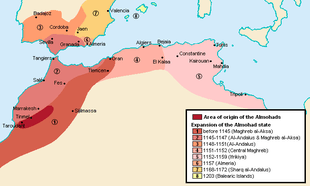
In early 1130, the Almohads finally descended from the mountains for their first sizeable attack in the lowlands. It was a disaster. The Almohads swept aside an Almoravid column that had come out to meet them before Aghmat, and then chased their remnant all the way to Marrakesh. They laid siege to Marrakesh for forty days until, in April (or May) 1130, the Almoravids sallied from the city and crushed the Almohads in the bloody Battle of al-Buhayra (named after a large garden east of the city). The Almohads were thoroughly routed, with huge losses. Half their leadership was killed in action, and the survivors only just managed to scramble back to the mountains.[16]
Ibn Tumart died shortly after, in August 1130. That the Almohad movement did not immediately collapse after such a devastating defeat and the death of their charismatic Mahdi, is a testament to the careful organization Ibn Tumart had built up at Tinmel. There was probably a struggle for succession, in which Abd al-Mu'min prevailed. Although a Zenata Berber from Targa (Algeria), and thus an alien among the Masmuda of southern Morocco, Abd al-Mu'min nonetheless saw off his principal rivals and hammered wavering tribes back to the fold. In an ostentatious gesture of defiance, in 1132, if only to remind the emir that the Almohads were not finished, Abd al-Mu'min led an audacious night operation that seized Tasghimout fortress and dismantled it thoroughly, carting off its great gates back to Tinmel.
Al-Andalus
| Caliphate خِلافة |
|---|
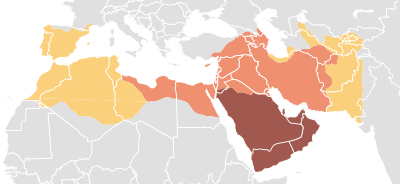 |
|
Main caliphates |
|
Parallel caliphates |
|
|
Abd al-Mu'min then came forward as the lieutenant of the Mahdi Ibn Tumart. Between 1130 and his death in 1163, Abd al-Mu'min not only rooted out the Murabits (Almoravids), but extended his power over all northern Africa as far as Egypt, becoming amir of Marrakesh in 1149.
Al-Andalus followed the fate of Africa. Between 1146 and 1173, the Almohads gradually wrested control from the Murabits over the Moorish principalities in Iberia. The Almohads transferred the capital of Moslem Iberia from Córdoba to Seville. They founded a great mosque there; its tower, the Giralda, was erected in 1184 to mark the accession of Ya'qub I. The Almohads also built a palace there called Al-Muwarak on the site of the modern day Alcázar of Seville.
The Almohad princes had a longer and more distinguished career than the Murabits. The successors of Abd al-Mumin, Abu Yaqub Yusuf (Yusuf I, ruled 1163–1184) and Abu Yusuf Yaqub al-Mansur (Yaʻqūb I, ruled 1184–1199), were both able men. Initially their government drove many Jewish and Christian subjects to take refuge in the growing Christian states of Portugal, Castile, and Aragon. Ultimately they became less fanatical than the Murabits, and Ya'qub al-Mansur was a highly accomplished man who wrote a good Arabic style and protected the philosopher Averroes. His title of "al-Manṣūr" ("the Victorious") was earned by his victory over Alfonso VIII of Castile in the Battle of Alarcos (1195).
From the time of Yusuf II, however, the Almohads governed their co-religionists in Iberia and central North Africa through lieutenants, their dominions outside Morocco being treated as provinces. When Almohad emirs crossed the Straits it was to lead a jihad against the Christians and then return to Morocco.[17]
Holding years
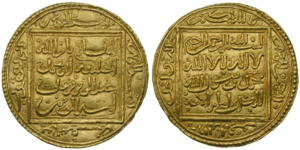
In 1212, the Almohad Caliph Muhammad 'al-Nasir' (1199–1214), the successor of al-Mansur, after an initially successful advance north, was defeated by an alliance of the four Christian kings of Castile, Aragón, Navarre, and Portugal, at the Battle of Las Navas de Tolosa in the Sierra Morena. The battle broke the Almohad advance, but the Christian powers remained too disorganized to profit from it immediately.
Before his death in 1213, al-Nasir appointed his young ten-year-old son as the next caliph Yusuf II "al-Mustansir". The Almohads passed through a period of effective regency for the young caliph, with power exercised by an oligarchy of elder family members, palace bureaucrats and leading nobles. The Almohad ministers were careful to negotiate a series of truces with the Christian kingdoms, which remained more-or-less in place for next fifteen years (the loss of Alcácer do Sal to the Kingdom of Portugal in 1217 was an exception).
In early 1224, the youthful caliph died in an accident, without any heirs. The palace bureaucrats in Marrakesh, led by the wazir Uthman ibn Jam'i, quickly engineered the election of his elderly grand-uncle, Abd al-Wahid I 'al-Makhlu', as the new Almohad caliph. But the rapid appointment upset other branches of the family, notably the brothers of the late al-Nasir, who governed in al-Andalus. The challenge was immediately raised by one of them, then governor in Murcia, who declared himself Caliph Abdallah al-Adil. With the help of his brothers, he quickly seized control of al-Andalus. His chief advisor, the shadowy Abu Zayd ibn Yujjan, tapped into his contacts in Marrakesh, and secured the deposition and assassination of Abd al-Wahid I, and the expulsion of the al-Jami'i clan.
This coup has been characterized as the pebble that finally broke al-Andalus. It was the first internal coup among the Almohads. The Almohad clan, despite occasional disagreements, had always remained tightly knit and loyally behind dynastic precedence. Caliph al-Adil's murderous breach of dynastic and constitutional propriety marred his acceptability to other Almohad sheikhs. One of the recusants was his cousin, Abd Allah al-Bayyasi ("the Baezan"), the Almohad governor of Jaén, who took a handful of followers and decamped for the hills around Baeza. He set up a rebel camp and forged an alliance with the hitherto quiet Ferdinand III of Castile. Sensing his greater priority was Marrakesh, where recusant Almohad sheikhs had rallied behind Yahya, another son of al-Nasir, al-Adil paid little attention to this little band of misfits.
Reconquista
In 1225, Abd Allah al-Bayyasi's band of rebels, accompanied by a large Castilian army, descended from the hills, besieging cities such as Jaén and Andújar. They raided throughout the regions of Jaén, Cordova and Vega de Granada and, before the end of the year, al-Bayyasi had established himself in the city of Cordova. Sensing a power vacuum, both Alfonso IX of León and Sancho II of Portugal opportunistically ordered raids into Andalusian territory that same year. With Almohad arms, men and cash dispatched to Morocco to help Caliph al-Adil impose himself in Marrakesh, there was little means to stop the sudden onslaught. In late 1225, with surprising ease, the Portuguese raiders reached the environs of Seville. Knowing they were outnumbered, the Almohad governors of the city refused to confront the Portuguese raiders, prompting the disgusted population of Seville to take matters into their own hands, raise a militia, and go out in the field by themselves. The result was a veritable massacre – the Portuguese men-at-arms easily mowed down the throng of poorly armed townsfolk. Thousands, perhaps as much as 20,000, were said to have been slain before the walls of Seville. A similar disaster befell a similar popular levy by Murcians at Aspe that same year. But Christian raiders had been stopped at Cáceres and Requena. Trust in the Almohad leadership was severely shaken by these events – the disasters were promptly blamed on the distractions of Caliph al-Adil and the incompetence and cowardice of his lieutenants, the successes credited to non-Almohad local leaders who rallied defenses.
But al-Adil's fortunes were briefly buoyed. In payment for Castilian assistance, al-Bayyasi had given Ferdinand III three strategic frontier fortresses: Baños de la Encina, Salvatierra (the old Order of Calatrava fortress near Ciudad Real) and Capilla. But Capilla refused to hand them over, forcing the Castilians to lay a long and difficult siege. The brave defiance of little Capilla, and the spectacle of al-Bayyasi's shipping provisions to the Castilian besiegers, shocked Andalusians and shifted sentiment back towards the Almohad caliph. A popular uprising broke out in Cordova – al-Bayyasi was killed and his head dispatched as a trophy to Marrakesh. But Caliph al-Adil did not rejoice in this victory for long – he was assassinated in Marrakesh in October 1227, by the partisans of Yahya, who was promptly acclaimed as the new Almohad caliph Yahya "al-Mu'tasim".
The Andalusian branch of the Almohads refused to accept this turn of events. Al-Adil's brother, then in Seville, proclaimed himself the new Almohad caliph Abd al-Ala Idris I 'al-Ma'mun'. He promptly purchased a truce from Ferdinand III in return for 300,000 maravedis, allowing him to organize and dispatch the greater part of the Almohad army in Spain across the straits in 1228 to confront Yahya.
That same year, Portuguese and Leonese renewed their raids deep into Muslim territory, basically unchecked. Feeling the Almohads had failed to protect them, popular uprisings took place throughout al-Andalus. City after city deposed their hapless Almohad governors and installed local strongmen in their place. A Murcian strongman, Muhammad ibn Yusuf ibn Hud al-Judhami, who claimed descendance from the Banu Hud dynasty that had once ruled the old taifa of Saragossa, emerged as the central figure of these rebellions, systematically dislodging Almohad garrisons through central Spain. In October 1228, with Spain practically all lost, al-Ma'mun abandoned Seville, taking what little remained of the Almohad army with him to Morocco. Ibn Hud immediately dispatched emissaries to distant Baghdad to offer recognition to the Abbasid Caliph, albeit taking up for himself a quasi-caliphal title, 'al-Mutawwakil'.
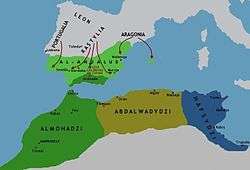
The departure of al-Ma'mun in 1228 marked the end of the Almohad era in Spain. Ibn Hud and the other local Andalusian strongmen were unable to stem the rising flood of Christian attacks, launched almost yearly by Sancho II of Portugal, Alfonso IX of León, Ferdinand III of Castile and James I of Aragon. The next twenty years saw a massive advance in the Christian reconquista – the old great Andalusian citadels fell in a grand sweep: Mérida and Badajoz in 1230 (to Leon), Majorca in 1230 (to Aragon), Beja in 1234 (to Portugal), Cordova in 1236 (to Castile), Valencia in 1238 (to Aragon), Niebla-Huelva in 1238 (to Leon), Silves in 1242 (to Portugal), Murcia in 1243 (to Castile), Jaén in 1246 (to Castile), Alicante in 1248 (to Castile), culminating in the fall of the greatest of Andalusian cities, the ex-Almohad capital of Seville, into Christian hands in 1248. Ferdinand III of Castile entered Seville as a conqueror on December 22, 1248.
The Andalusians were helpless before this onslaught. Ibn Hudd had attempted to check the Leonese advance early on, but most of his Andalusian army was destroyed at the battle of Alange in 1230. Ibn Hud scrambled to move remaining arms and men to save threatened or besieged Andalusian citadels, but with so many attacks at once, it was a hopeless endeavor. After Ibn Hud's death in 1238, some of the Andalusian cities, in a last-ditch effort to save themselves, offered themselves once again to the Almohads, but to no avail. The Almohads would not return.
With the departure of the Almohads, the Nasrid dynasty ("Banū Naṣr", Arabic: بنو نصر) rose to power in Granada. After the great Christian advance of 1228–1248, the Emirate of Granada was practically all that remained of old al-Andalus. Some of the captured citadels (e.g. Murcia, Jaen, Niebla) were reorganized as tributary vassals for a few more years, but most were annexed by the 1260s. Granada alone would remain independent for an additional 250 years, flourishing as the new center of al-Andalus.
Collapse in the Maghreb
In their African holdings, the Almohads encouraged the establishment of Christians even in Fez, and after the Battle of Las Navas de Tolosa they occasionally entered into alliances with the kings of Castile. They were successful in expelling the garrisons placed in some of the coast towns by the Norman kings of Sicily. The history of their decline differs from that of the Almoravids, whom they had displaced. They were not assailed by a great religious movement, but lost territories, piecemeal, by the revolt of tribes and districts. Their most effective enemies were the Banu Marin (Marinids) who founded the next dynasty. The last representative of the line, Idris II, 'al-Wathiq', was reduced to the possession of Marrakesh, where he was murdered by a slave in 1269.
Culture
Literature
The Almohads worked to suppress the influence of Maliki fiqh—even publicly burning copies of Muwatta Imam Malik and Maliki commentaries. They sought to disseminate the doctrine of Ibn Tumart, author of E'az Ma Yutlab (أعز ما يُطلب The Most Noble Calling), Muhadhi al-Muwatta' (محاذي الموطأ Counterpart of the Muwatta'), and Talkhis Sahih Muslim (تلخيص صحيح مسلم Compendium of Sahih Muslim).[18][19]
Literary production continued despite the devastating effect the Almohad reforms had on cultural life in their domain. Almohad universities continued the knowledge of preceding Andalusi scholars as well as ancient Greco-Roman writers; contemporary literary figures included Ibn Rushd (Averroes), Hafsa bint al-Hajj al-Rukuniyya, Ibn Tufail, Ibn Zuhr, Ibn al-Abbar, Ibn Amira and many more poets, philosophers, and scholars. The abolishment of the dhimmi status further stifled the once flourishing Jewish Andalusi cultural scene; Maimonides went east and many Jews moved to Castillian-controlled Toledo.
According to the research of Muhammad al-Manuni, there were 400 paper mills in Fes under the reign of Sutlan Yaqub al-Mansur in 12th century.[20]
Theology
In terms of Muslim jurisprudence, the state gave recognition to the Zahiri (ظاهري) school of thought,[21] though Shafi'ites were also given a measure of authority at times. While not all Almohad leaders were Zahirites, quite a few of them were not only adherents of the legal school but also well-versed in its tenets.[22] Additionally, all Almohad leaders – both the religiously learned and the laymen – were hostile toward the Malikite school favored by the Almoravids. During the reign of Abu Yaqub, chief judge Ibn Maḍāʾ oversaw the banning of all religious books written by non-Zahirites;[23] when Abu Yaqub's son Abu Yusuf took the throne, he ordered Ibn Maḍāʾ to undertake the actual burning of such books.[24] In terms of Islamic theology, the Almohads were Ash'arites, their Zahirite-Ash'arism giving rise to a complicated blend of literalist jurisprudence and esoteric dogmatics.[25][26]
Art
A publication from the Metropolitan Museum of Art describes the white and green glazed tiles on the minaret of the Kutubiyya Mosque as the oldest example of zellij, or Mauro-Iberian geometric tilework.[27]
The Almohad dynasty embraced a style of Maghrebi script known today as "Maghrebi thuluth" as an official style used in manuscripts, coinage, documents, and more.[28] Scribes and calligraphers of the Almohad period also started to illuminate words and phrases in manuscripts for emphasis, using gold leaf and lapis lazuli.[28]
Architecture
The main sites of Almohad architecture and art include Fes, Marrakesh, Rabat and Seville.[29] Figurative arts suffered somewhat from the orthodox interpretation of the Quran, which forbade human representation, and thus the genre of art which flourished mostly in the Almohad lands was architecture.
The Almohads reduced decorations, and introduced the use of geometrical holes, following in general the principle of expressing a certain degree of magnificence. As centuries passed, the buildings had increasingly oriental appearance and similar structures: mosques with rectangular plans, divided into naves with pillars, as well as a wide use of horseshoe-shaped arches. The most common building material was brickwork, followed by mortar. Foreign influence can be seen in domes of Egyptian origin and, in the civil sector, the triumphal arches inspired by those in Egypt. The construction of fortifications with towers was also widespread.
The main Almohad structures include the Great Mosque of Tinmel,[30] the Giralda of the former mosque of Seville (founded in 1171), the Koutoubia Mosque and the Bab Ksiba of the Kasbah of Marrakech, the Hassan Tower of Rabat and the Atalaya Castle in Andalusia.
 Mihrab of the Great Mosque of Tinmel.
Mihrab of the Great Mosque of Tinmel. La Giralda.
La Giralda. Minaret of the Kutubiyya Mosque.
Minaret of the Kutubiyya Mosque.._Reales_Alc%C3%A1zares_de_Sevilla.jpg) The south portico of the Patio del Yeso of the Alcázar of Seville, built during the Almohad period.
The south portico of the Patio del Yeso of the Alcázar of Seville, built during the Almohad period.
 The Almohad minaret in Safi.
The Almohad minaret in Safi.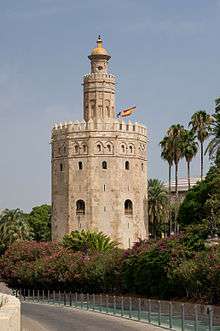
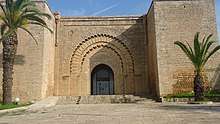 Bab Ruwah meaning 'Gate of the Winds' in Rabat, Morocco
Bab Ruwah meaning 'Gate of the Winds' in Rabat, Morocco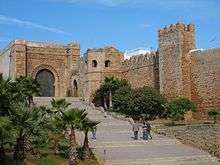 Kasbah of the Udayas in Rabat, Morocco was founded during the Almohad dynasty.
Kasbah of the Udayas in Rabat, Morocco was founded during the Almohad dynasty.
Status of non-Muslims
The Almohads had taken control of the Almoravid Maghribi and Andalusian territories by 1147.[31] The Almohads rejected the mainstream Islamic doctrine that established the status of "dhimmi", a non-Muslim resident of a Muslim country who was allowed to practice his religion on condition of submission to Muslim rule and payment of jizya.[32]
The treatment of Jews under Almohad rule was a drastic change. Prior to Almohad rule during the Caliphate of Córdoba, Jewish culture experienced a Golden Age. María Rosa Menocal, a specialist in Iberian literature at Yale University, has argued that "tolerance was an inherent aspect of Andalusian society", and that the Jewish dhimmis living under the Caliphate, while allowed fewer rights than Muslims, were still better off than in Christian Europe.[33] Many Jews migrated to al-Andalus, where they were not just tolerated but allowed to practice their faith openly. Christians had also practiced their religion openly in Córdoba, and both Jews and Christians lived openly in Morocco as well.
The first Almohad leader, Abd al-Mumin, allowed an initial seven-month grace period.[34] Then he forced most of the urban dhimmi population in Morocco, both Jewish and Christian, to convert to Islam.[32]
Those who converted had to wear identifying clothing since they were not regarded as sincere Muslims.[32] Cases of mass martyrdom of Jews who refused to convert to Islam are recorded.[34]
Many of the conversions were superficial. Maimonides urged Jews to choose the superficial conversion over martyrdom and argued, "Muslims know very well that we do not mean what we say, and that what we say is only to escape the ruler's punishment and to satisfy him with this simple confession."[32] Abraham Ibn Ezra (1089–1164), who himself fled the persecutions of the Almohads, composed an elegy mourning the destruction of many Jewish communities throughout Spain and the Maghreb under the Almohads.[35] Many Jews fled from territories ruled by the Almohads to Christian lands, and others, like the family of Maimonides, fled east to more tolerant Muslim lands.[36] However, a few Jewish traders still working in North Africa are recorded.[34]
The treatment of Christians under Almohad rule was a drastic change. Many Christians were killed, forced to convert or forced to flee. Some Christians fled to the Christian kingdoms in the north and west and helped fuel the Reconquista. Martyrs under Almohad rule included:
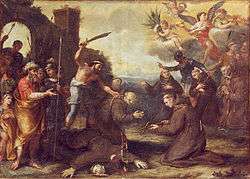
- Daniel and companions, d. 1221
- John of Perugia and Peter of Sassoferrato, d. 1231
- Saint Serapion of Algiers, d. 1240
Idris al-Ma'mun, a late Almohad pretender (ruled 1229–1232 in parts of Morocco), renounced much Almohad doctrine, including the identification of Ibn Tumart as the Mahdi, and the denial of dhimmi status. He allowed Jews to practice their religion openly in Marrakesh and even allowed a Christian church there as part of his alliance with Castile.[32] In Iberia, Almohad rule collapsed in the 1200s and was succeeded by several "Taifa" kingdoms, which allowed Jews to practice their religion openly.[32]
List of Almohad caliphs (1121–1269)
- Ibn Tumart 1121–1130
- Abd al-Mu'min 1130–1163
- Abu Ya'qub Yusuf I 1163–1184
- Abu Yusuf Ya'qub 'al-Mansur' 1184–1199
- Muhammad al-Nasir 1199–1213
- Abu Ya'qub Yusuf II 'al-Mustansir' 1213–1224
- Abu Muhammad Abd al-Wahid I 'al-Makhlu' 1224
- Abdallah al-Adil 1224–1227
- Yahya 'al-Mutasim' 1227–1229
- Abu al-Ala Idris I al-Ma'mun, 1229–1232
- Abu Muhammad Abd al-Wahid II 'al-Rashid' 1232–1242
- Abu al-Hassan Ali 'al-Said' 1242–1248
- Abu Hafs Umar 'al-Murtada', 1248–1266
- Abu al-Ula (Abu Dabbus) Idris II 'al-Wathiq' 1266–1269
| Almohad family tree | |||||||||||||||||||||||||||||||||||||||||||||||||||||||||||||||||||||||||||||||||||||||||||||||||||||||||||||||||||||||||||||||||||||||||||||||||||||||||||||||||||||||||||||||||||||||||||||||||||||||||||||||||||||||||||||||||||||||||||||||||||||||||||||||||||||||||||||||||||||||||||||||||||||||||||||||||||||||||||||||||||||||||||||||||||||||||||||||||||||||||||||||||||||||||||||||||||||||||||||||||||||||||||||||||||||||||||||||||||||||||||||||||||||||||||||||||||||||||||||||||||||||||||||||||||||||||||||||||||||||||||||||||||||||||||||||||||||||||||||||||||||||||||||||||||||||||||||||||||||||||||||||||||||||||||||||||||||||||||||||||||||||||||||||||||||||||||||||||||||||||||||||||||||||||||||||||||||||||||||||||||||||||||||||||||||||||||||||||||||||||||||||||||||||||||||||||||||||||||||||||||||||||||||||||||||||||||||||||||||||||||||||||||||||||||||||||||||||||||||||||||||||||||||||||||||||||||||||||||||||||||||||||||||||||||||||||||||||||||||||||||||||||||||||||||||||||||||||||||||||
|---|---|---|---|---|---|---|---|---|---|---|---|---|---|---|---|---|---|---|---|---|---|---|---|---|---|---|---|---|---|---|---|---|---|---|---|---|---|---|---|---|---|---|---|---|---|---|---|---|---|---|---|---|---|---|---|---|---|---|---|---|---|---|---|---|---|---|---|---|---|---|---|---|---|---|---|---|---|---|---|---|---|---|---|---|---|---|---|---|---|---|---|---|---|---|---|---|---|---|---|---|---|---|---|---|---|---|---|---|---|---|---|---|---|---|---|---|---|---|---|---|---|---|---|---|---|---|---|---|---|---|---|---|---|---|---|---|---|---|---|---|---|---|---|---|---|---|---|---|---|---|---|---|---|---|---|---|---|---|---|---|---|---|---|---|---|---|---|---|---|---|---|---|---|---|---|---|---|---|---|---|---|---|---|---|---|---|---|---|---|---|---|---|---|---|---|---|---|---|---|---|---|---|---|---|---|---|---|---|---|---|---|---|---|---|---|---|---|---|---|---|---|---|---|---|---|---|---|---|---|---|---|---|---|---|---|---|---|---|---|---|---|---|---|---|---|---|---|---|---|---|---|---|---|---|---|---|---|---|---|---|---|---|---|---|---|---|---|---|---|---|---|---|---|---|---|---|---|---|---|---|---|---|---|---|---|---|---|---|---|---|---|---|---|---|---|---|---|---|---|---|---|---|---|---|---|---|---|---|---|---|---|---|---|---|---|---|---|---|---|---|---|---|---|---|---|---|---|---|---|---|---|---|---|---|---|---|---|---|---|---|---|---|---|---|---|---|---|---|---|---|---|---|---|---|---|---|---|---|---|---|---|---|---|---|---|---|---|---|---|---|---|---|---|---|---|---|---|---|---|---|---|---|---|---|---|---|---|---|---|---|---|---|---|---|---|---|---|---|---|---|---|---|---|---|---|---|---|---|---|---|---|---|---|---|---|---|---|---|---|---|---|---|---|---|---|---|---|---|---|---|---|---|---|---|---|---|---|---|---|---|---|---|---|---|---|---|---|---|---|---|---|---|---|---|---|---|---|---|---|---|---|---|---|---|---|---|---|---|---|---|---|---|---|---|---|---|---|---|---|---|---|---|---|---|---|---|---|---|---|---|---|---|---|---|---|---|---|---|---|---|---|---|---|---|---|---|---|---|---|---|---|---|---|---|---|---|---|---|---|---|---|---|---|---|---|---|---|---|---|---|---|---|---|---|---|---|---|---|---|---|---|---|---|---|---|---|---|---|---|---|---|---|---|---|---|---|---|---|---|---|---|---|---|---|---|---|---|---|---|---|---|---|---|---|---|---|---|---|---|---|---|---|---|---|---|---|---|---|---|---|---|---|---|---|---|---|---|---|---|---|---|---|---|---|---|---|---|---|---|---|---|---|---|---|---|---|---|---|---|---|---|---|---|---|---|---|---|---|---|---|---|---|---|---|---|---|---|---|---|---|---|---|---|---|---|---|---|---|---|---|---|---|---|---|---|---|---|---|---|---|---|---|---|---|---|---|---|---|---|---|---|---|---|---|---|---|---|---|---|---|---|---|---|---|---|---|---|---|---|---|---|---|---|---|---|---|---|---|---|---|---|---|---|---|---|---|---|---|---|---|---|---|---|---|---|---|---|---|---|---|---|---|---|---|---|---|---|---|---|---|---|---|---|---|---|---|---|---|---|---|---|---|---|---|---|---|---|---|---|---|---|---|---|---|---|---|---|---|---|---|---|---|---|---|---|---|---|---|---|---|---|---|---|---|---|---|---|---|---|---|---|---|---|---|---|---|---|---|---|---|---|---|---|---|---|---|---|---|---|---|---|---|---|---|---|---|---|---|---|---|---|---|---|---|---|---|---|---|---|---|---|---|---|---|---|---|---|---|---|---|---|---|---|---|---|---|---|---|---|---|---|---|---|---|---|---|---|---|---|---|---|---|---|---|---|---|---|---|---|---|---|---|---|---|---|---|---|---|---|---|---|---|---|---|---|---|---|---|---|---|---|---|---|---|---|---|---|---|---|---|---|---|---|---|---|---|---|---|---|---|---|---|---|---|---|---|---|---|---|---|---|---|---|---|---|---|---|---|---|---|---|---|---|---|---|---|---|---|---|---|---|---|---|---|---|---|---|---|---|---|---|---|---|---|---|---|---|---|---|---|---|---|---|---|---|---|---|---|---|---|---|---|---|---|---|---|---|---|---|---|---|---|---|---|---|---|---|---|---|---|---|---|---|---|---|---|---|---|---|---|---|---|---|---|---|---|---|---|---|
| |||||||||||||||||||||||||||||||||||||||||||||||||||||||||||||||||||||||||||||||||||||||||||||||||||||||||||||||||||||||||||||||||||||||||||||||||||||||||||||||||||||||||||||||||||||||||||||||||||||||||||||||||||||||||||||||||||||||||||||||||||||||||||||||||||||||||||||||||||||||||||||||||||||||||||||||||||||||||||||||||||||||||||||||||||||||||||||||||||||||||||||||||||||||||||||||||||||||||||||||||||||||||||||||||||||||||||||||||||||||||||||||||||||||||||||||||||||||||||||||||||||||||||||||||||||||||||||||||||||||||||||||||||||||||||||||||||||||||||||||||||||||||||||||||||||||||||||||||||||||||||||||||||||||||||||||||||||||||||||||||||||||||||||||||||||||||||||||||||||||||||||||||||||||||||||||||||||||||||||||||||||||||||||||||||||||||||||||||||||||||||||||||||||||||||||||||||||||||||||||||||||||||||||||||||||||||||||||||||||||||||||||||||||||||||||||||||||||||||||||||||||||||||||||||||||||||||||||||||||||||||||||||||||||||||||||||||||||||||||||||||||||||||||||||||||||||||||||||||||||
See also
References
- "Qantara". Archived from the original on 2016-06-11. Retrieved 2013-02-21.
- "Qantara". Archived from the original on 2016-06-11. Retrieved 2013-02-21.
- "Qantara". Archived from the original on 2016-06-11. Retrieved 2013-02-21.
- "Qantara". Archived from the original on 2016-06-11. Retrieved 2013-02-21.
- Le Moyen Âge, XIe- XVe siècle, par Michel Kaplan & Patrick Boucheron. p.213, Ed. Breal 1994 (ISBN 2-85394-732-7)
- Taagepera, Rein (September 1997). "Expansion and Contraction Patterns of Large Polities: Context for Russia". International Studies Quarterly. 41 (3): 475–504. doi:10.1111/0020-8833.00053. JSTOR 2600793.
- Turchin, Peter; Adams, Jonathan M.; Hall, Thomas D (December 2006). "East-West Orientation of Historical Empires". Journal of World-Systems Research. 12 (2): 222. doi:10.5195/JWSR.2006.369. ISSN 1076-156X.
- (in French) P. Buresi, La frontière entre chrétienté et islam dans la péninsule Ibérique, pp.101–102. Ed. Publibook 2004 (ISBN 9782748306446)
- Yalsizuçanlar, Sadik (2016-11-25). Itinéraires d'un soufi: Récits d'Ibn'Arabî (in French). Editions du Cerf. ISBN 978-2-204-12038-8.
- "Almohads - confederation".
- Gerhard Bowering; Patricia Crone; Mahan Mirza; Wadad Kadi; Muhammad Qasim Zaman; Devin J. Stewart (2013). The Princeton Encyclopedia of Islamic Political Thought. Princeton University Press. p. 34. ISBN 978-0-691-13484-0.
- "Almohads - Islamic Studies - obo". Oxford Bibliographies. 6 Jan 2020. Retrieved 11 Feb 2020.
- Buresi, Pascal; El Aallaoui, Hicham (2012). Governing the Empire: Provincial Administration in the Almohad Caliphate (1224–1269). Studies in the History and Society of the Maghrib. 3. Leiden: Brill. ISBN 978-90-04-23333-1.
- Bennison, Amira K. (2016). Almoravid and Almohad Empires. Edinburgh University Press. pp. 299–300, 306. ISBN 9780748646821.
- Julien, p.100
- The Encyclopedia of Islam, Volume 6, Fascicules 107-108. The Encyclopaedia of Islam. Brill. 1989. p. 592. ISBN 978-90-04-09082-8. Retrieved 2019-02-01.
- Barton, Simon (2009). A History of Spain. London: Palgrave Macmillan. pp. 63–66. ISBN 978-0-230-20012-8.
- Bongianino, Umberto (Feb 8, 2018). The Ideological Power of Some Almohad Illuminated Manuscripts (Lecture).
- Bongianino, Umberto (Feb 8, 2018). The Ideological Power of Some Almohad Illuminated Manuscripts (Lecture).
- Sijelmassi, Mohamed (1987). ذخائر مخطوطات الخزانة الملكية بالمغرب: (Bibliothèque al-Hassania) (in French). www.acr-edition.com. ISBN 978-2-86770-025-5.
- H. M. Balyuzi, Muḥammad and the Course of Islám, pg. 306. George Ronald, 1976. ISBN 9780853980605
- Adang, "The Spread of Zahirism in al-Andalus in the Post-Caliphal Period: The evidence from the biographical dictionaries," pg. 297-346. Taken from Ideas, Images and Methods of Portrayal: Insights into Classical Arabic Literature and Islam. Ed. Sebastian Gunther, Leiden: 2005.
- Kees Versteegh, The Arabic Linguistic Tradition, pg. 142. Part of Landmarks in Linguistic Thought series, vol. 3. New York: Routledge, 1997. ISBN 9780415157575
- Shawqi Daif, Introduction to Ibn Mada's Refutation of the Grammarians, pg. 6. Cairo, 1947.
- Kojiro Nakamura, "Ibn Mada's Criticism of Arab Grammarians." Orient, v. 10, pp. 89–113. 1974
- Pascal Buresi and Hicham El Aallaoui, Governing the Empire: Provincial Administration in the Almohad Caliphate 1224-1269, p. 170. Volume 3 of Studies in the History and Society of the Maghrib. Leiden: Brill Publishers, 2012. ISBN 9789004233331
- Bloom, Jonathan (Jonathan M.), author. The minbar from the Kutubiyya Mosque. ISBN 978-0-300-20025-6. OCLC 949266877.CS1 maint: multiple names: authors list (link)
- Bongianino, Umberto (Feb 8, 2018). The Ideological Power of Some Almohad Illuminated Manuscripts (Lecture).
- Le muse, De Agostini, Novara, 1964, Vol. I pp. 152–153
- Centre, UNESCO World Heritage. "Mosquée de Tinmel". UNESCO World Heritage Centre. Retrieved 2020-03-21.
- "Islamic world" Encyclopædia Britannica Online. Retrieved September 2, 2007.
- M.J. Viguera, "Almohads". In Encyclopedia of Jews in the Islamic World, Executive Editor Norman A. Stillman. First published online: 2010 First print edition: ISBN 978-90-04-17678-2, 2014
- María Rosa Menocal, The Ornament of the World: How Muslims, Jews, and Christians created a culture of tolerance in medieval Spain
- Amira K. Bennison and María Ángeles Gallego. "Jewish Trading in Fes On The Eve of the Almohad Conquest." MEAH, sección Hebreo 56 (2007), 33-51
- Ross Brann, Power in the Portrayal: Representations of Jews and Muslims in Eleventh- and Twelfth-Century Islamic Spain, Princeton University Press, 2009, pp. 121–122.
- Frank and Leaman, 2003, pp. 137–138.
Sources
- Bel, Alfred (1903). Les Benou Ghânya: Derniers Représentants de l'empire Almoravide et Leur Lutte Contre l'empire Almohade. Paris: E. Leroux.
- Coppée, Henry (1881). Conquest of Spain by the Arab-Moors. Boston: Little, Brown. OCLC 13304630.
- Dozy, Reinhart (1881). History of the Almohades (Second ed.). Leiden: E. J. Brill. OCLC 13648381.
- Goldziher, Ignác (1903). Le livre de Mohammed ibn Toumert: Mahdi des Almohades (PDF). Alger: P. Fontana.
- Kennedy, Hugh N. (1996). Muslim Spain and Portugal: A Political History of al-Andalus. New York: Longman. pp. 196–266. ISBN 978-0-582-49515-9.
- Popa, Marcel D.; Matei, Horia C. (1988). Mica Enciclopedie de Istorie Universala. Bucharest: Editura Politica. OCLC 895214574.
External links
- Almohads Dynasty : Islamic Architecture
- Abd al-Mumin life among Masmudas: Encyclopædia Britannica
- Al-Andalus: the art of Islamic Spain, an exhibition catalog from The Metropolitan Museum of Art (fully available online as PDF), which contains material on Almohad Caliphate (see index)
— Royal house — Almohad dynasty | ||
| Preceded by Almoravid dynasty |
Ruling house of Morocco 1147–1244 |
Succeeded by Marinid dynasty |
